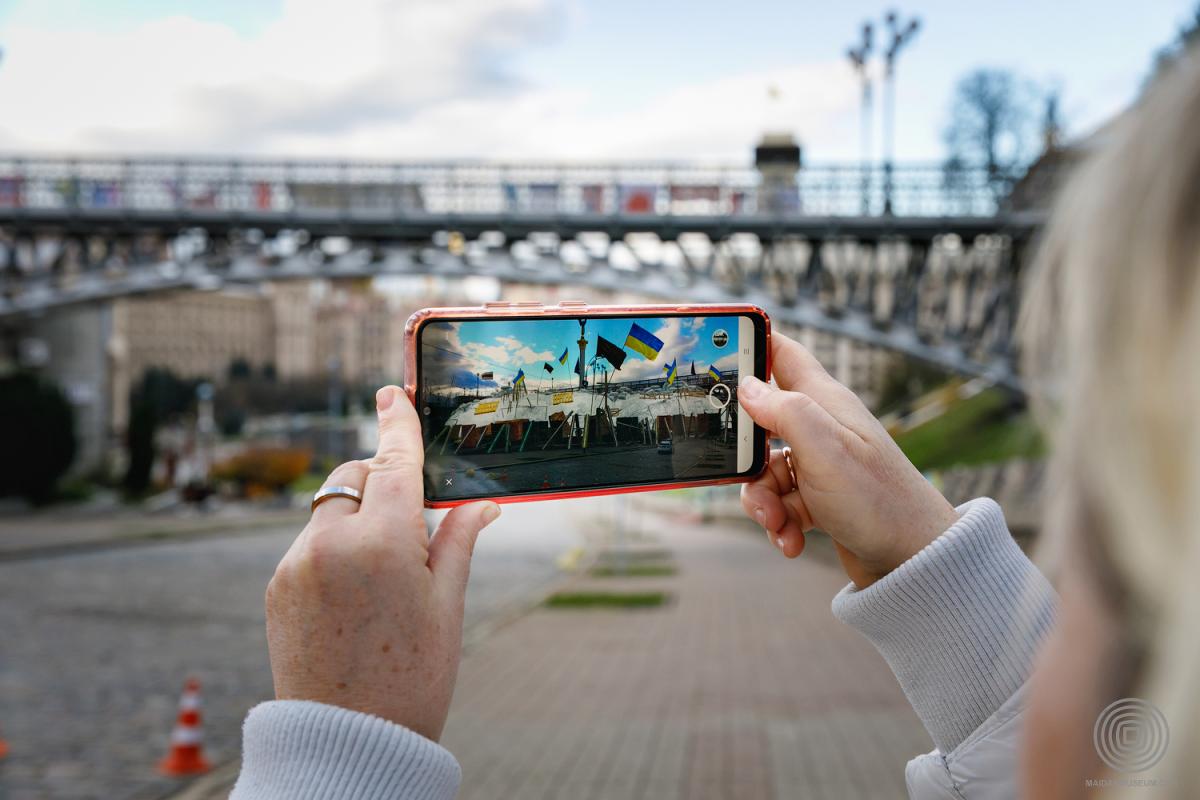
Now, everybody in Kyiv can see the 10 most famous objects from the Revolution of Dignity. The Maidan Museum has presented the project Territory of Dignity in Augmented Reality: Museification of Maidan Monuments.
10 stands in key locations of the Revolution of Dignity tell the story of the largest protest in Ukraine's modern history.
Anyone with a smartphone can recreate the Maidan space in real time with the help of a few QR codes. AR helped revive barricades, elements of the Tent City, the infamous Yolka, and the Art Barbican.
"This project is not just a reconstruction of objects, but also a part of our monument protection program. We are working to ensure that the locations associated with the Revolution of Dignity are properly preserved. The barricades no longer exist, and the Yolka no longer exists, but thanks to AR, the spatial location acquires the meaning of material, specific value. It will help us convey the values of the Maidan even better," said Olha Salo, curator and author of the project, Deputy Director General of the National Museum of the Revolution of Dignity.
The Maidan Museum's attempt to revive the Kyiv Maidan of 2013-2014 using AR was made possible by the support of the Ukrainian Cultural Foundation. The project Territory of Dignity in AR: Museification of Maidan Monuments is dedicated to the 10th anniversary of the Revolution. To ensure that the AR objects closely replicate the real ones in sizes and proportions, authors had to process over 15,000 photos from the Maidan. 
"While working on the project, we were overcome with nostalgia many times. You look at the picture and suddenly realize that for you it's much more. There are so many faces, events, and memories behind this one frame. This project has other parts: a website, where you can view the objects, a reference note with all the information and descriptions of historical events related to the site, a photo gallery that shows the reality of the Maidan, and videos, that allow viewers to emerge themselves into time and space of the Revolution of Dignity," shares Anastasia Haidukevych-Kachuro, project manager, researcher at the National Museum of the Revolution of Dignity.
While walking through Maidan Square, people can also view the 3D models of elements from everyday life and protective gear created by the protesters. Acting Minister of Culture and Information Policy Rostyslav Karandieiev emphasized that this project will be useful for educators to provide deeper coverage of the Maidan events.
"Thanks to this project, many people who weren't around during the Maidan, will be able to imagine how things happened in real life. It's an important step for preserving our memory. It is important to continue this practice of institutionalization and museumification, creating the right conditions for the history of the Ukrainian struggle for independence and its important stage, the Revolution of Dignity, to be honored and preserved for future generations," said Rostyslav Karandieiev, acting Minister of Culture and Information Policy.
Using immersive technologies, the specialists recreated 3D models of ten places of significance for Euromaidan. These include barricades near the Central Department Store, near the Trade Union Building and on European Square, Instytutska Street, now the Heavenly Hundred Heroes Alley, and Mykhailo Hrushevsky Street. One can also use a smartphone to see the elements of the Tent City, the Yolka structure, and the Art Barbican. Museum exhibits, such as shields, helmets, and other items that have become symbols of Euromaidan, are also available in 3D.
 Artem Chyhyrynskyi, executive director of ADVIN, the company whose specialists developed the 3D digital models and the online platform that brings them to life:
Artem Chyhyrynskyi, executive director of ADVIN, the company whose specialists developed the 3D digital models and the online platform that brings them to life:
"Young people who have never been to Maidan can see what the barricades, Yolka, and the Tent City looked like. We tried to bring people's perception as close as possible to what it was like in reality ten years ago, in the same place, in the same space. When you think back to those events, it takes your breath away from the sense of community present on the Maidan."
Ostap Stasiv, a participant in the Revolution of Dignity, one of the founders of the Open University of Maidan (OUM), and a participant in the Russian-Ukrainian war, shared his impressions of the project:
"I am glad that now we will have the opportunity to go back to the Maidan in other ways than our memories. Our memory defines our future. And, perhaps, this project is one of the bricks in the structure of our future. During the war, I have been rethinking my Maidan experience. I realize, that the Maidan was a rubicon that launched many processes. We used to say, 'It is the best thing that has ever happened to us'."
Anyone can explore the AR objects or attend guided tours of the Revolution of Dignity sites from the Maidan Museum. If you would like to share your memories of the revolutionary events and donate photos or items to the Museum, please contact us at maidanmuseum@gmail.com
